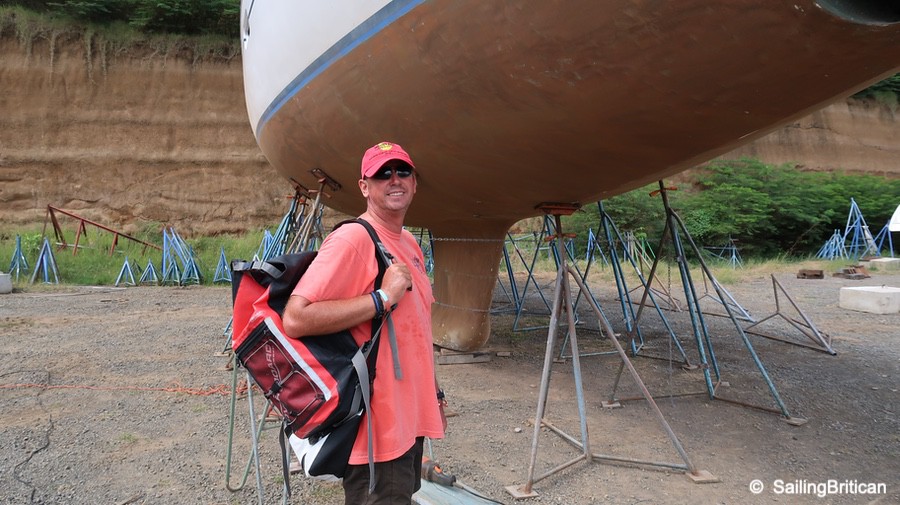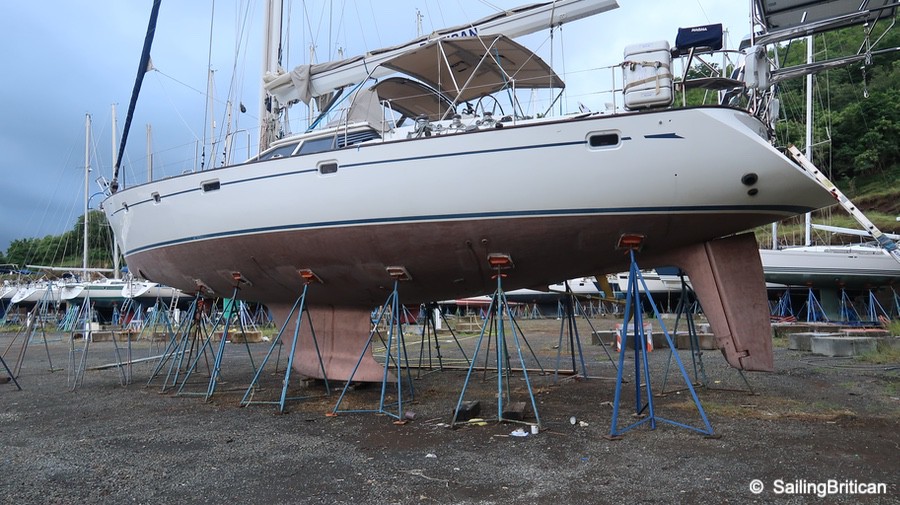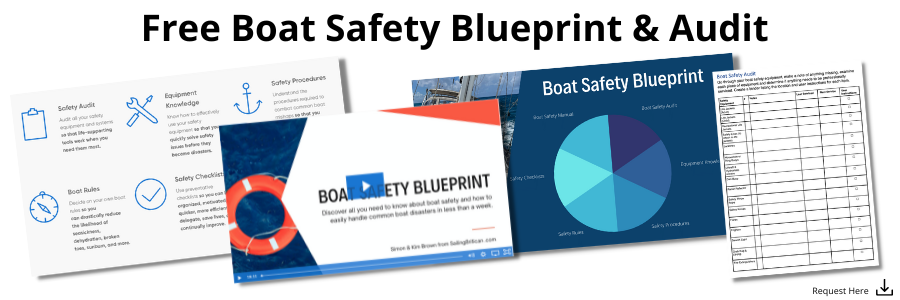Below you’ll find seven CopperCoat tips to help better ensure your CopperCoat Antifoul application is a success rather than a disaster. These tips are based on using the services of a boatyard rather than applying the product yourself. Almost all DIY applications are “first-timers” and they usually go well because instructions are followed. The application of Coppercoat is very easy to get right but also easy to get wrong, diligence is the key.

7 CopperCoat Tips For A Successful Application
1. Select a boatyard with a proven track record with numerous happy CopperCoat clients.
Once you decide that CopperCoat is the way to go the next step is to find a boatyard that can do the job properly. Properly being the keyword! This is our number one CopperCoat tip. We’ve had two failed CopperCoat applications, both from very well-known boatyards. Don’t go on the reputation of the boatyard! Find several boatyard customers that have had successful applications. Furthermore, ensure you get the same manager/team that has done the previous applications. Note that every boatyard will say that they’ve done CopperCoat applications or that they know how to do it. Do not take this as reliable information.
2. Understand the CopperCoat application process yourself.
Make sure you know the full CopperCoat application process. There are written instructions and CopperCoat has a video you can watch: CopperCoat Overview. The application process is simply the correct number of units of Coppercoat applied wet on tacky (therefore all in the same day) to a properly prepared surface. The number of units of Coppercoat applied is important, work this out using the online calculator and keep painting until it is all used up. It’s worth noting that in hot dry conditions and on large boat painting may be continuous. While in cooler conditions and on smaller boats half an hour or more may be needed before the next coat can be applied.
3. Ask the manager/team responsible for the job how they plan on doing the job.
Quiz the manager to find out if he/she knows the full instructions, potential problem areas and when he/she plans on completing the work. Determine what has to happen to the condition of the hull before the product is applied. Question how many people will be working on the application, for how long and the estimated number of coats that will be put on. Ultimately determine if your knowledge of the process matches that of the manager’s. If it doesn’t consider walking away.
4. Determine a plan for adverse weather.
What’s going to happen if it rains for a week or if the weather isn’t cooperating as it should? Will the boatyard put protection over the boat? At what cost? You need to protect the paint job from rain for 24 hours in hot/dry conditions. And 48 hours in cooler UK and North America conditions. Carry on reading for more CopperCoat tips.

5. Confirm your expectations in writing and determine how the boatyard will guarantee the work.
If the boat goes back in the water and you find the hull covered in barnacles after a couple of months what course of action will you take? How will you ensure the stated course of action will be accepted by the boatyard. What is acceptable and what is not acceptable? Get your expectations in writing and confirmation that the said boatyard/manager agrees that your expectations are realistic. Furthermore, determine what you can do to protect your investment.
6. Supervise the entire job.
Ensure that you supervise the preparation of the hull. Be onsite for the full application process – the actual paint job will only take hours, not days. Watch the team combine the products, ensure the paint is going on within the appropriate time frame and count the number of coats that are applied to the hull of the boat. During the sanding, stage make sure that the team gets the hull to the appropriate smoothness required to activate the Copper in the paint. Take pictures and videos!
7. Stick around before sailing away.
The biggest issue we’ve had with boatyard jobs is not that they don’t guarantee their work. It’s that they do guarantee their work but by the time we discover they’ve done a bad job we’re in another country! With CopperCoat being such a large investment, the ideal situation is to stay close by until you determine that the application did, indeed, work. Get the boat in the water and allow it to sit around for at least a couple of months so you can confirm the results you’re looking for.

Here are the links to all our CopperCoat Problems Videos:
To get an overview of all our CopperCoat videos and articles please visit: CopperCoatAntifouling Review Otherwise, get more in-depth information below.
- September 2016 – Our First Failed Application by Bennett Brothers in Wilmington, North Carolina. Watch here: CopperCoat Antifoul Failure
- September 2017 – An Update On Our CopperCoat Results One Year Later. It didn’t work! Get the full CopperCoat antifouling review story, up to this point, by reading Our CopperCoat Antifoul Problems
- October 2017 – CopperCoat USA & Bennet Brothers Work To Rectify Our Issues. To see our boat hauled out in Charleston and the USA representative from CopperCoat inspect the hull, watch our sailing Vlog episode that covers our CopperCoat antifouling review entitled: Liveaboard Life
- July 2018 – Haul Out In Trinidad & Tobago – All The Patches Were Barnacle Free But the Rest of the Boat was Full of Barnacles! To view our haul out in Trinidad and get more information about the second failed application, watch the second video on our Trinidad & Tobago Destinations section entitled Haul Out Trinidad & Tobago.
- August 2019 – Evidence of our Failed Peake’s Boatyard Application and Attempted Sanding Touch-up in Antigua. And September 2019 – Arrangements for CopperCoat UK To Come To Grenada. You can see both the August and September 2019 videos here: CopperCoat Antifouling Solution
- November 2019 – Our Third & Final CopperCoat Antifoul Application by Mr. CopperCoat Himself. Watch here: CopperCoat Application
- June 2020 – The Results Of Our Third Full CopperCoat Application Are…?!?!?! Find out here: CopperCoat Problems
Any other CopperCoat tips you can offer?
Or any comments or questions? Please leave them below.

Hi Guys,
After reading your seven points of getting ones boat CC, I totally understand why the application process needs to meticulously followed. Applicators of the product are probably experienced at painting as is my painter but they have inherent habits of painting and tests where lies the problem. From all my research into CC Its a arduous start and stay focused until after the last coat is applied. Follow the instructions well and hey presto job done.
I am unsure about keeping it weather-proofed for 24 hours after the last coat but that is a preference best last for the owner to make.
Because of its nature I strongly recommend that vigilant security be taken by the boat owner during application for the added benefit of due diligence and only until the last coat is applied should one rest. Take a siesster over a cold on would be highly encouraged.
BZ to Britican for standing up and being noticed. I hope the antifoul does its job from here into many days in the sun.
May I offer my condolences on you loss of your grand dad. He will say the he had a good innings at 95 for one of you.
Good Cheer for you all over this festive season.
Looking forward to your next post
Kind Regards
Brian in NZ
Hi Guys,
Hope it works this time.
I was looking a buying a 60/70 ft schooner but mist out, well next time.
Hi Simon,
Glad to see your last video and that you are now aware of the application issues you’ve experienced.
To your tips I would add that burnishing with rough abrasive pad (like Scotchbrite pad) after 320 grit sanding prior to launch will expose the copper particles in the valleys of the surface ripples that you can see in your closeups. Sanding may not get the amine blush off in those small depressions, depending on how smooth & fair the new Coppercoat surface is.
Also, are you planning on just leaving the hull untouched for 2 months? You may be disappointed , yet again. It is recommended to fairly regularly wipe off the slime that will grow on CopperCoat, depending on the waters you are cruising. Copper is an effective deterrent for settling of animal larvae like tubeworm, limpets, and yes, various barnacles species. BUT, it is not magic. If you allow a layer of plant species to establish, that provides cover for the barnacle larvae to attach. Then they get to lay down their ring of shell, which further protects them, and as the ring grows, it cuts through the vegetative layer to the surface CopperCoat.
So when you go for a swim, have a wipe of the hull. If slime rubs off, then give the hull a gentle once over with mild abrasive pad to remove the slime layer, as preventative maintenance of your new CopperCoat job, so it can do its job.
Hi
I just wanted to say that the sanding process is to remove the epoxy resin off the surfaces of the copper flakes. After the sanding is done (which also flattens out the ridges inherent in roller application), the resin can be removed from the little valley areas with stainless steel wool (or bronze wool). The more the copper flakes are exposed, the more effective the antifouling. The copper erodes (more like degrades) at 4 to 4.4 micrometera a year from those 40 to 44 micrometer thick copper flakes (in seawater). If enough copper coat is applied, all that needs to be done is repairs and resanding. IF, enough is applied the first time. I thought their resin was awfully thin. I used a medium viscosity resin with an additive that allowed recoating up to seven days later without sw
Good to hear the UK manufacturer of CC stood behind their product and supervised this attempt. It will be interesting to see your assessment in say 3 months and after the hull has been moving through the water. Hope you enjoy the Christmas break in the UK.👍
Hi All,
My wife and I purchased a Vector 39 w Copper Coat applied by the boatyard by the previous owner. The PO had the boat in fresh water near Portland Oregon for 10 years or so after the CC application. There was a slime all over the hull when we went for survey and I was very skeptical before pressure wash. A few months later we crossed the Colombia river bar and sailed her up to Seattle. A year later we hauled her and I sanded her w 80 grit orbital sander(wish I had read a bit more about the right way to reactivate). All this to say she is still barnacle free after about 15 years now. Will probably need to do a reapplication of CC at next haul out. Time will tell. Fair winds and hope this was helpful to hear!
Golden Ticket II Seattle, WA
That’s great to hear Elliot. So far our CC is looking amazing. We’ve already noticed a massive difference with this latest application. Thank you for commenting. Smiles, Kim
Thank you for your comments Christopher 🙂 Kim
Hi Britican crew
I hope things are well with you
I was looking at the copper coat issues you had ,
Is it solved ?
I have a 44 foot sailboat and want to use copper coat
Do you recommend it ?
I saw the recommandations , I will be applying the product myself with friends
Good wind , stay safe
Louis -Marie Rioux
Hey Louis – Marie Rioux. Our CopperCoat issues have been resolved! I recommend the product 100%… Just make sure you follow the instructions exactly and you’ll be very pleased. Kim
I’ve applied copper coat 3 months ago. Living in high growth water I found a few spots with barnicals taking hold (where I hadn’t sanded enough) whilst still in the water I took to the areas with wet and dry 400g (NEVER A SCRAPER) THUMB NAILED off a few tougher guys and sanded to expose the copper balls. Now only a slight slim/dirt film. I feel I have got copper coat working well. Time will tell but from everything I’ve researched. Kitchen scrubbing pad or fine wet n dry . Never never use metal scrapper
Great news Paul – sounds like you’ve got it all sorted out. I like to hear positive stories like that. Thank you for sharing. Smiles, Kim
I am currently undergoing the agony of prepping the boat for copper coat. Removed all the previous anti fouling down to my 2 base coats of interlux barrier coat. Applied 3 new coat of Pettit barrier coat. Now sanding my ass off to get to the baby smooth surface CC requires. I am into the second layer of barrier coat. I have asked CC if there is an etching solution as they claim CC will not bond into any depression no matter how small. CC states that if any surface no matter how small the depression CC will not adhere and will bubble. I got blown off by Pettit and CC when I inquired. It seems to me that CC should be able to chemically bond to any substrate. Rolled on it will get into the depressions, with a suitable etching compound the only issue left would be the final sanding and buffing. Prep would be easier and safer for CC.
Hi
I gather from your comments above that the application by Mr CopperCoat was successful. But I can’t find a link to the video you say shows the final outcome. I’ve seen the one with Mr CC in action.
cheers
Chris
Hey Chris – I think this is the final update: https://youtu.be/6JkCzOZ9k_Q Smiles, Kim